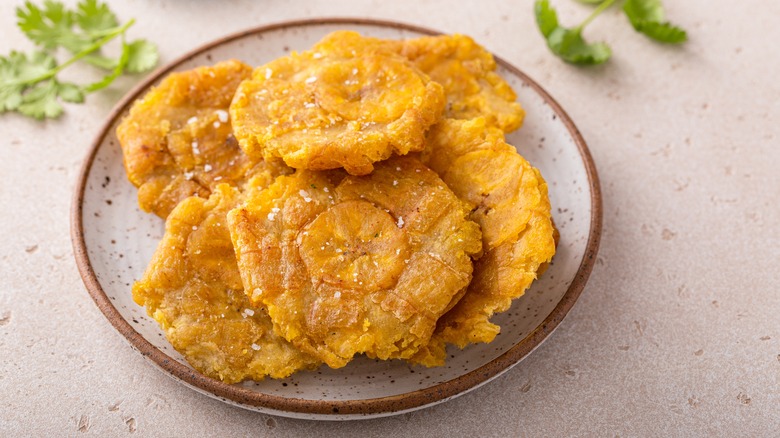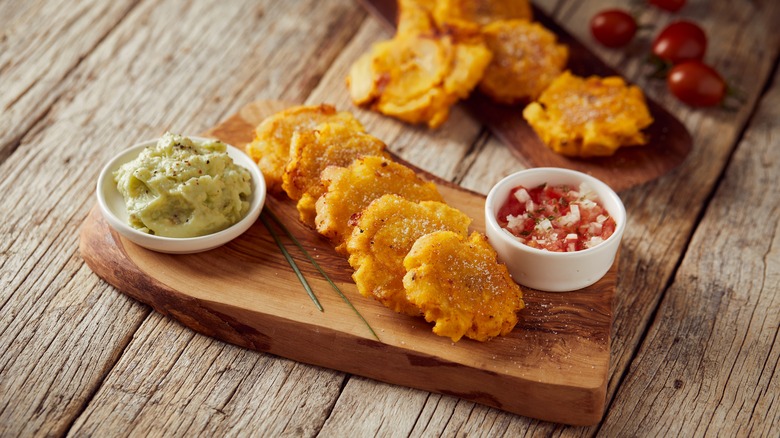Making Tostones? Stop Using The Wrong Plantains
Tostones are a delicious, salty side dish or snack common in the cuisines of Puerto Rican, Caribbean, South, and Central American cultures. Making them at home is a snap and calls for only a few ingredients — most of which you probably already have on hand (salt and oil, anyone?). But like many dishes with a short list of elements, making sure you have the right version of each is critical.
Being that tostones are simply seasoned and fried plantains, the most important decision you'll make is selecting your fruit; the wrong plantains can ruin the dish. Typically, you'll find plantains on a color spectrum that indicates ripeness — the greener they are, the less ripe, while yellow tells you that they're getting sweeter, and black means they're fully there. While the riper fruit is flavorful and perfect for maduros (another fried plantain preparation), for the purpose of making tostones, the plantains you want are green, unripe, firm, and as unblemished as possible.
Why green plantains are best for the process
Making tostones requires a double fry, the first time as "coins" about an inch thick, and then a second time after you've smashed them into flat rounds. This requires that they be sturdy enough to stand up to this process. The yellow or black plantains will soften — much the way a banana does as it ripens — and are more likely to fall apart when subject to multiple high-heat fries and smashing. The green plantains, on the other hand, are firmer, as their starches haven't yet been converted into sugar. This means their composition is more reminiscent of a raw potato than a banana, which is why tostones may also remind you a bit of French fries — crispy on the outside with a fluffy, soft interior.
There are some additional practices that will help ensure success: For example, before frying up tostones, make sure to soak your plantains in water with lime juice (some suggest doing this before the first fry, while others recommend soaking in between the two). And while plantain chips are also a tasty treat (for which you'll also want to know how to choose the right plantains for the crispiest version), you don't want to slice your plantains too thin for tostones — you need them to be substantial enough to smash and maintain that contrasting texture.
Why these plantains are best for seasoning tostones
An added benefit of using green plantains for tostones is that the flavor is very mild and relatively neutral, as opposed to the super sweet yellow and black versions. This means you can experiment with seasonings and sauces for an almost endless amount of flavor combinations.
Although they're technically a fruit, plantains are usually treated more like a savory vegetable or tuber. With that in mind, seasoning can be as basic as salt and pepper, but garlic powder is common, too, as is a squeeze of lime juice. A spice blend of cinnamon, cloves, nutmeg, cayenne, and ginger is Caribbean-inspired and aromatic and makes your tostones a flavor-packed contrasting side dish for something like a subtle grilled fish.
Dipping sauces can be as ubiquitous as mayonnaise or even ketchup (or a combo), but the simple starchiness of the tostone also serves as a great canvas for something a bit more complex, like a fruity mango salsa, a cilantro chimichurri, or a garlicky mojo sauce. Your classic fresh guacamole recipe is a perfect partner for tostones, too. By using the right plantains for your tostones, there's almost no way to go wrong.


